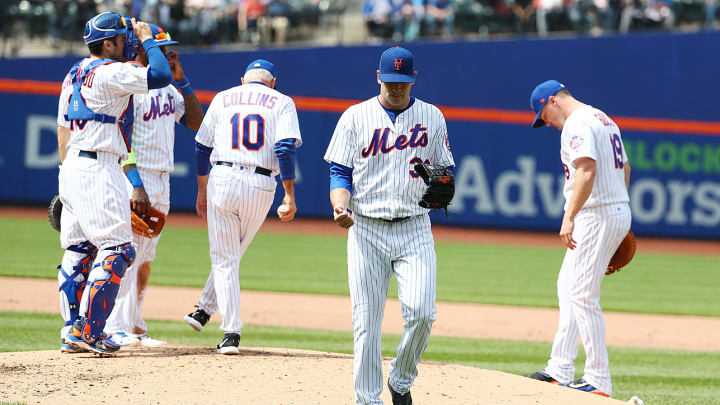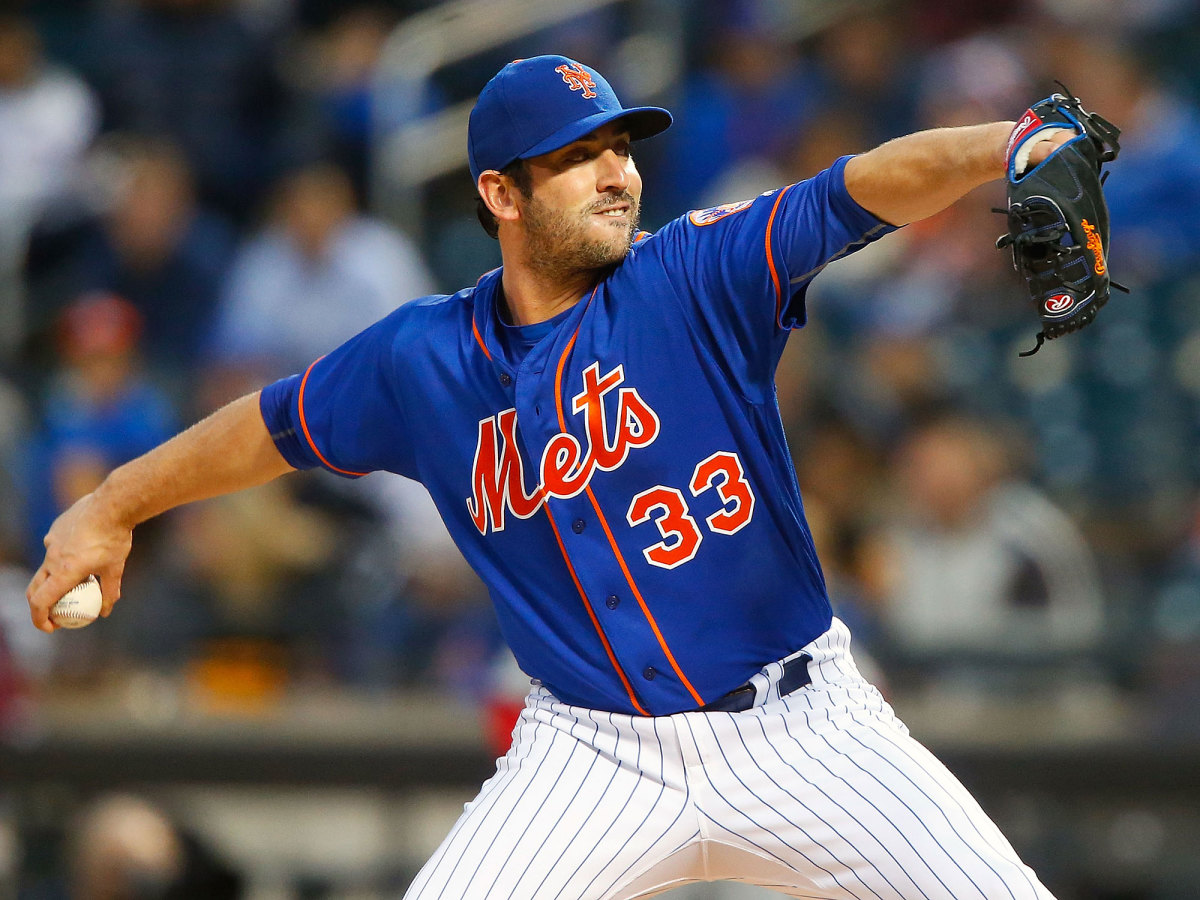'Windows close fast': For Matt Harvey and the Mets, it may soon be time to move on

Even before his head hurt too much to call in sick after a day of golfing, and even before he burned whatever precious capital he has left with New York Mets fans, Matt Harvey was a reclamation project. He was just another beat-up pitcher trying to salvage the early promise of his career. Now that his best fastball is gone, and that his arm is compromised by two surgeries, and that the klieg lights of New York that once flattered him have chastened him, Harvey faces another challenge to his reclamation: It may have to happen out of New York if it happens at all.
Harvey is a weathered 28 years old. It seems ages ago that he stepped on a big league mound for the first time, in 2012 in Arizona, and hit 99 mph with his fastball and 92 with his slider and looked like the next Justin Verlander. Two starts later his fastball reached 100 mph. Soon he owned New York.
But today Harvey, like Yasiel Puig and Tim Tebow, is famous for being famous, not for compiling a superstar’s resume. He has thrown fewer innings, made fewer starts and won fewer games than Michael Pineda. He never has won 15 games, made 30 starts or thrown 200 innings. Tommy John surgery, thoracic outlet surgery and the mechanical compromises he made to throw harder have derailed his ascendency. It’s a common story in baseball these days in the pursuit of almighty velocity.
Harvey can be a free agent after next season. Before then there is a greater possibility that the Mets trade him rather than extend him (though not any time soon, not when his value is so low and New York, which stands 15-16 entering play Tuesday, needs pitching). On Sunday, a day Harvey was supposed to start at Citi Field against the Marlins, the club instead suspended him for three days. The message seemed clear: the Mets exasperation with him had reached critical mass. Teams protect their valuable, trusted assets.
A change of scenery might do him well. The question is, what kind of value can be wrung from a diminished Harvey? I put that question to a veteran general manager, and got this response.
“I just went through our pitch data on him. It has regressed so much since 2012-13, especially the fastball. I think he has pitchability—he showed it in ’15—and I think he has a chance to morph into a different pitcher and very effective pitcher. The question is, will his makeup allow it?”
In 2013, at the height of Harvey’s powers, I dubbed him the Dark Knight for an SI cover story because he had a hero complex (and dark countenance) for a franchise that needed saving. He wanted everything about New York, even the expectations.
SI VAULT: The Dark Knight of Gotham, 05.20.2013
I asked Harvey then what it felt like on the days he brought his “A” game to the mound. “Power,” he told me. “It’s pretty exciting, knowing I can throw a 92 mph slider and start it down the middle and it ends up in the dirt. When I can reach back and run it up there at 98 and 99 when I want and drop a slider in there and throw a curveball for a strike and fade a changeup away to a lefty, it’s pretty fun.”
Today the life on his fastball is gone. Here are the signs of a power pitcher in decline:
Year | Spin Rate | Whiff Rate |
|---|---|---|
2015 | 2,338 rpm | 10.27% |
2016 | 2,232 rpm | 8.16% |
2017 | 2,199 rpm | 6.41% |
The upper end of his heater is diminished, even on occasions when he rears back and needs escaping from trouble. In 2013, Harvey hit 99 mph 20 times in 27 starts. He has thrown a pitch that hard in only two of his 36 starts over the past 2 ½ seasons. He is throwing his slider more than ever before in his career.
“Think about where the Mets were less than two years ago,” a rival executive said even before Harvey’s disciplinary problem surfaced over the weekend. “They were in the World Series with four young stud starters and another one on the mend. How quickly it all changed. Windows close fast sometimes.”
Matt Harvey needs to grow up, step up and apologize to the Mets
Jacob deGrom, 29, is back from a second elbow surgery and piling up strikeouts, but not with the same command. His walk rate has nearly doubled. Noah Syndergaard, 24, is gone for three months after tearing a lat muscle, following an off-season in which the Mets feared he packed on too much muscle without a throwing program. Steven Matz and his rebuilt left elbow can’t stay healthy; he turns 26 this month and has never thrown 150 innings in any season since he was drafted eight years ago. Zack Wheeler turns 27 this month, has thrown just 311 2/3 major league innings and remains a below-average strike thrower. Harvey is in a fourth season of rehabilitation of some sort. All but Syndergaard have already had Tommy John surgery, a procedure invented to address wear and tear but one that has become a young man’s rite of pitching initiation.
Mets manager Terry Collins opined in spring training that he hoped his young Fab Five could make 30 starts each. There may never be a season when all five make half that many starts for the Mets.
Once so flush with young pitching the Mets hardly blinked to trade Michael Fulmer—now the reigning AL Rookie of the Year for the Tigers—New York has been forced to enlist the likes of Adam Wilk and Tommy Milone to start games.

The breakdown of young pitchers is the reason why Theo Epstein and Jed Hoyer told me for my book, The Cubs Way; The Zen of Building the Best Team in Baseball and Breaking the Curse, that when they built the Cubs from the ground up they banked on position players, not pitchers.
“We really focused so much on acquiring bats and position players because we knew that was the safer path for us to take,” Hoyer said. “People thought, you guys are taking the wrong path because you win through pitching. But that’s not the way we saw it.
“Safety. That was a big part of it. We knew we had one chance to do this. We only had so long to draft at the top of the draft. So we took the safest route. We bought bonds instead of stocks.”
Every team but one drafted a pitcher in the first 30 picks of the five drafts since Epstein and Hoyer arrived in Chicago in the fall of 2011. The exception: the Cubs.
In 2007, for example, major league teams spent $25 million on 23 high school pitchers before the Angels drafted Harvey in the third round. (He did not sign, choosing instead to attend North Carolina.) Thirteen of those 23 top young pitchers never made the big leagues, a 57% failure rate. Only three are big league starters today: the Giants' Madison Bumgarner, the Red Sox' Rick Porcello and the Royals' Danny Duffy.
“I get it,” one scouting director told me after I wrote that 38% of pitchers drafted in the top 30 between 2012 and '15 had endured Tommy John surgery or thoracic outlet surgery. “The numbers are terrible. But if a kid is out there throwing 97, there is risk is not taking him. And if you draft the finesse kid who is throwing 88-90, you get killed for not taking the kid throwing 97.”
Despite advances in training and nutrition, pitchers are at least the same health risks—if not more so—as they were a generation ago. Harvey is a good example why. The amateur market is driven by velocity, a mentality that has trickled up to the major leagues, where the ease of accumulating and analyzing data encourages velocity. (In general, the faster a pitcher throws, the more margin of error he gains and the more strikeouts he can secure.)
Five years after his four-homer game, Josh Hamilton's playing days may be finished
As a high school senior, Harvey threw 91-95 mph and his 6'4", 195-pound frame had him described as “lanky.” Two years later, as a sophomore at UNC, he weighed 255 pounds, showed inconsistent velocity and posted a 5.40 ERA. (He later admitted he gained “a lot of muscle” that season through “some stupid workouts,” which presaged the yo-yoing of his weight in the big leagues.) He rallied with a big junior year to become the seventh overall pick of the 2010 draft.
Along the way, building upon the mechanics he learned from his father, Ed, who taught him to “show the ball to second base” on his arm swing, Harvey tweaked his mechanics to generate more velocity.
“I’ve got the higher arm slot,” he told me, “so for me to get up and let my arm work I have to really stay back a lot longer and get my arm out a little sooner. At this point it’s natural. When I was learning, I always pointed to second.”
Pointing the ball toward second base was commonly taught, though some pitching experts today believe it creates more stress on the shoulder and arm, preferring a righthanded pitcher, for instance, to “show” the ball more toward third base or shortstop in the load phase.
Moreover, to get to his high arm slot, Harvey loads the ball far away from his head and so high that his right elbow gets higher than his shoulder, creating a stressful position known as elevated distal humerus.
But if you can throw a baseball 100 mph, where is the incentive to change? The incentive only comes with failure or injury, which have brought Harvey to this next phase of his career: the transition phase.
Harvey deserves the opportunity to defend himself for his actions Saturday, when reports claimed that he suffered so badly from a headache that he texted pitching coach Dan Warthen that he could not make it to Citi Field for the game against Miami. (Protocol requires a player in such situation to call, not text, either the trainer or Collins.)
Whether the cause of his three-game suspension was “miscommunication” or a dereliction of his professional obligations is great tabloid fodder, but it is of relatively minor importance in the scope of his career and the direction of the Mets.
Coming off a second serious surgery, and needing more time to see if his once-fearsome fastball can return, Harvey should not be judged against his greatness from 2013. He is a recuperating pitcher in transition. He should be measured by incremental progress. In the meantime, when and where he might successfully make that transition are mysteries greater than his headache Saturday.
